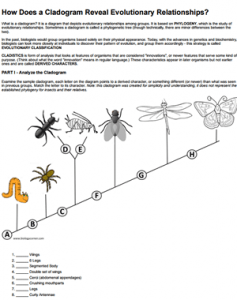
This activity gives a short explanation of phylogeny and how cladograms are used to show evolutionary relationships. Students analyze a diagram and identify derived characters, such as wings and other appendages.
The features are given as a list and students must determine where on the list to match it. For example, “double set of wings” goes with the letter “G” because moths and butterflies both have two sets of wings.
Once students understand how to analyze a cladogram, they must construct their own cladogram that includes a slug, catfish, frog, tiger, and human. A table helps them establish characteristics that are present or absent in each group.
Grade Level: 9-12
Time Required: 30-40 min
HS-LS4-1 Communicate scientific information that common ancestry and biological evolution are supported by multiple lines of empirical evidence

